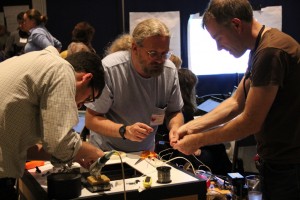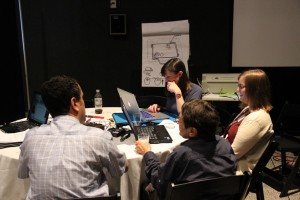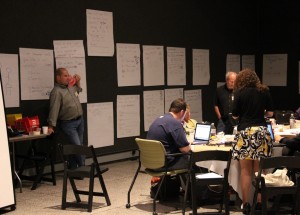CMME Workshop Part 2: Developing Innovative Accessible Digital Interactives
Building off of ideas from CMME’s Possibilities Workshop, we moved into the second-half of the week and the Concept Development Workshop. This post describes what happened at this second, slightly smaller workshop and the innovative design approaches that participants created.
The Concept Development Workshop featured 40 participants working on different design teams to develop possible approaches to a universally designed digital interactive. The teams worked on one of four specified approaches they had heard about earlier in the week:
- dynamic haptic display
- data sonification
- personalization options
- multi-touch audio layers
Each team had a range of professionals including exhibit designers, exhibit developers, technical designers, evaluators, non-museum professionals, core team members, and a disability advisor. In particular, we challenged the teams to develop possible approaches for a universally designed data representation interactive exhibit –since museums frequently present data-based content and this information can be difficult for all visitors to understand.
Below are brief descriptions of what the different teams shared with each other at the end of the workshop about their work. Be sure to check-back often since the CMME team is pursuing ideas from all of these presentations and will continue to update the site with the latest news about our development process.
The group which focused on haptic displays developed a rough prototype which included a “vibrating puck.” This puck allowed visitors, through tactile feedback, to compare their data point with others and to observe trends in the data. The team explored how different levels of vibrating feedback would allow visitors to understand where their particular measurement was located and how it related to other people’s data points. Watch the video below to see a workshop participant using the dynamic haptic display prototype.
The sonification group focused on using sound to provide audio cues for visitors to be able to understand the larger trends of a data set and to be able to locate their personal data point. The prototype which they presented to the group consisted of a tactile slider overlaid on a graph. By moving the tactile slider, a visitor’s hand would travel along the x and y axis of a graph simultaneously triggering different types of pitches corresponding to data points. The team was able to use code developed by Georgia Tech’s Sonification Lab to provide an auditory indication of trends within the data or where a visitor’s own data point was located. Watch the video below to see team members testing the data sonification prototype.
One group at the workshop focused on personalization within exhibits and tackled the broader issue of what a personalized museum experience might look like. The group explored different variables that visitors might want to personalize at a digital interactive such as text size and contrast, audio speed and volume, and the use of image descriptions. Given the vast range of users who come to museums and their varying needs, this group developed a series of questions that museum exhibits would pose to visitors to facilitate personalization. They also considered where and how these questions would be asked to visitors. The photo below shows the team brainstorming about the series of personalization questions.
You can find information about the group that worked on adding an audio layer to a multi-touch table here in Jim’s blog post.
All of the groups made impressive headway in thinking about how each of these four approaches could be integrated into a museum exhibit that incorporates data and digital technology. The core team plans to incorporate ideas from all of the groups as it moves forward creating their various CMME deliverables, including an exemplar interactive, a DIY toolkit for other museum professionals, and papers bringing new ideas to the larger field.
by Marta Beyer ![]() on November 9, 2012
on November 9, 2012


